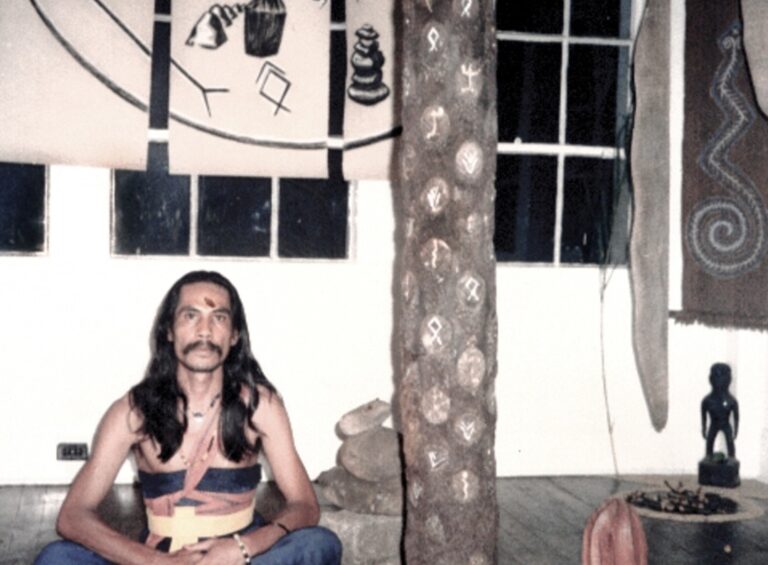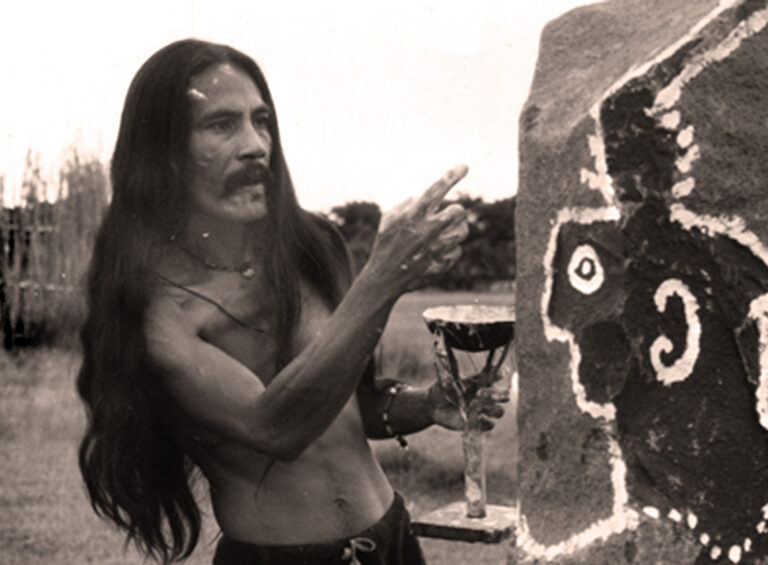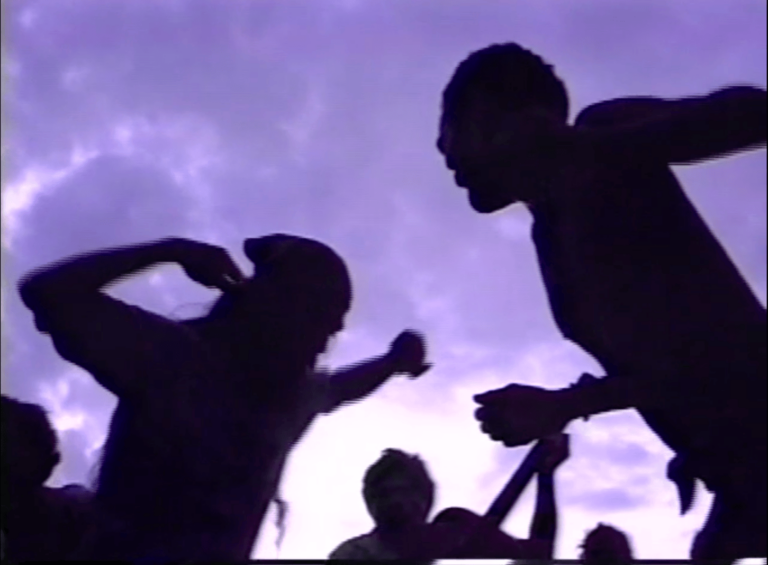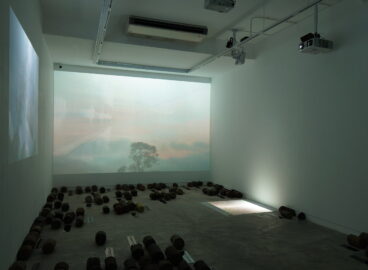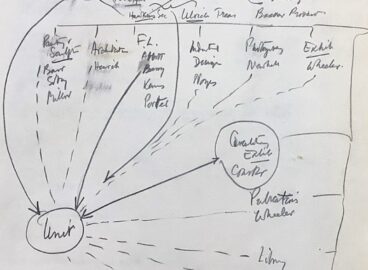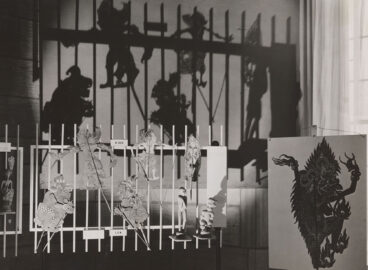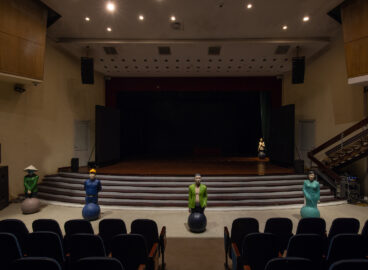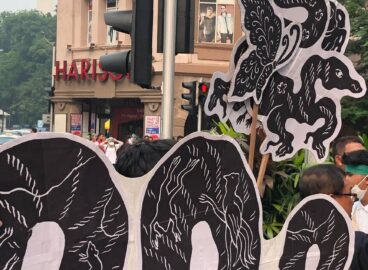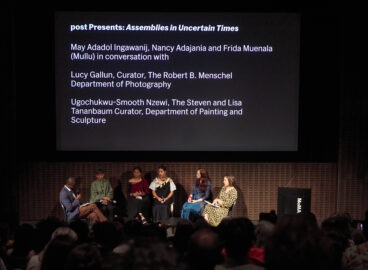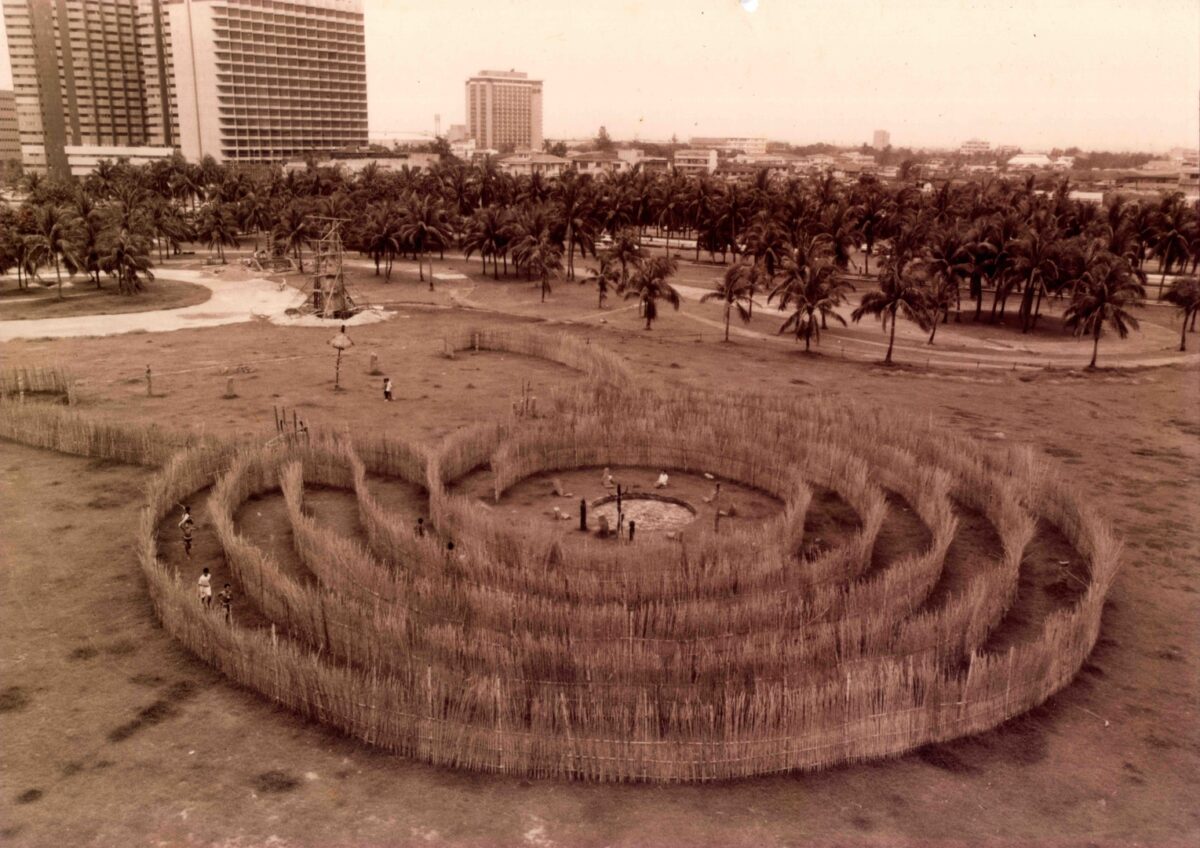
The performances conducted by the late Filipino artist Roberto Villanueva (1947–1995) prompted the effects and the facture of ritual. In 1989, a sprawling circular labyrinth constructed out of eight-foot runo reeds occupied the grounds of the Cultural Center of the Philippines (CCP) in Metro Manila. Inspired by a pattern found in the Cordilleran rice fields of northern Luzon, the labyrinth orchestrated a walk, or dance, toward the center, where one found a circular pit lined with river stones and presided over by totemic figures like the bulul, a carved wooden sculpture representing a guardian spirit. The center was an area resembling a dap-ay, a place for gatherings and rites, traditionally the foundation of Cordilleran learning. Archetypes: Cordillera Labyrinth, like many of Villanueva’s works, combined installation, chanting, magical invocations, and other ritualistic tropes drawn from Indigenous sources.1The installation is also referred to as Uman di Biag (Garden of Life). Writer Charlson L. Ong, in a 1989 article for the Daily Globe, articulates a popular impression of Villanueva toward the height of the artist’s prolific practice: “[Villanueva is] most everyone’s idea of a mumbaki—a Cordilleran shaman who invokes ancestral and nature spirits.”2Charlson L. Ong, “Tales of the Mumbaki,” Daily Globe [Manila], May 22, 1989.
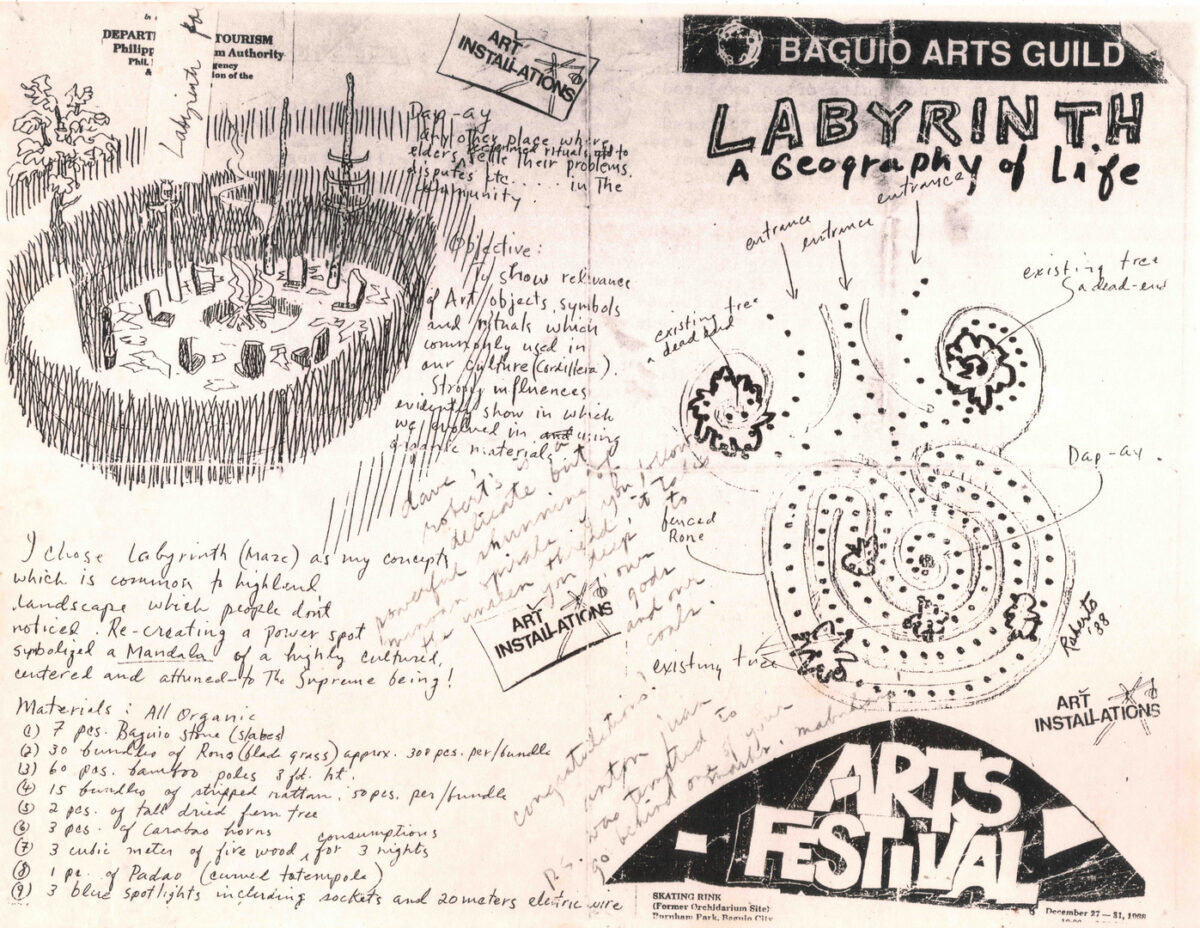
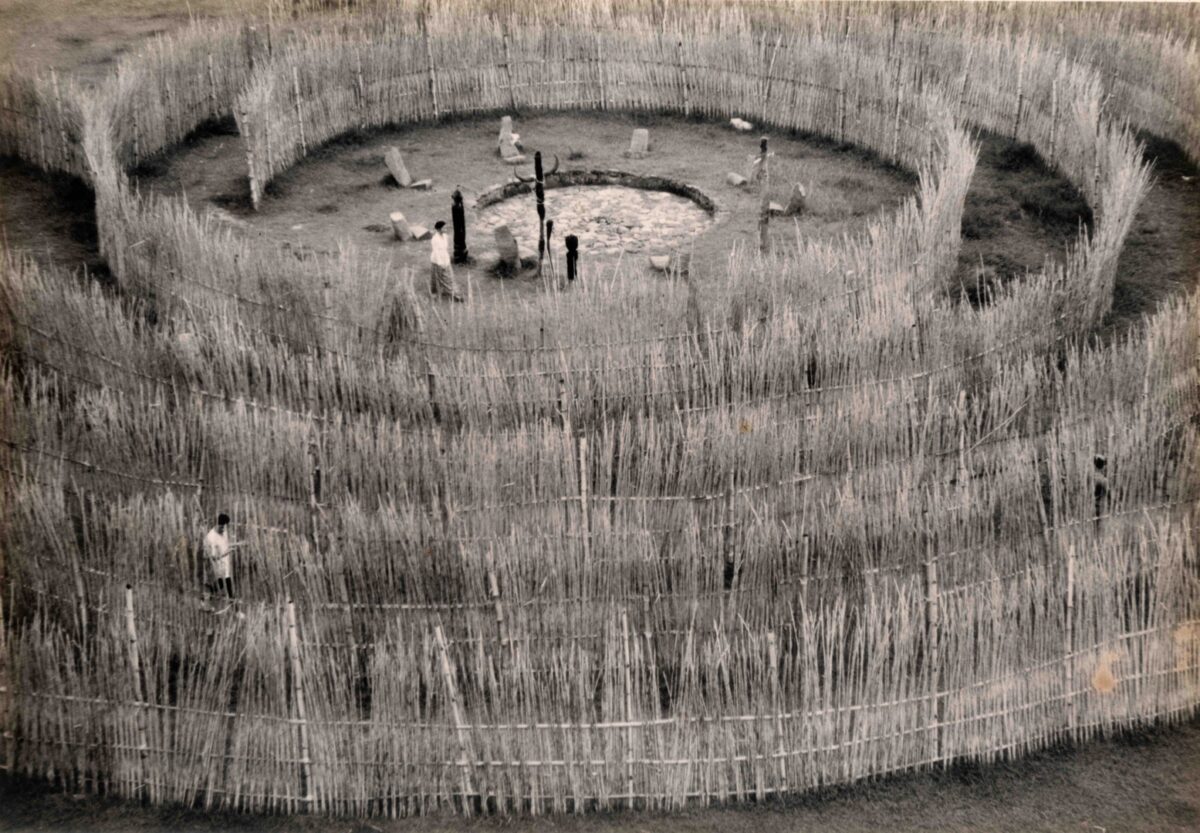
The events that signaled the opening and dismantling of the maze aspired to states of revelry and trance by way of an eclectic ensemble. Musicians wearing their malong, or tubular garments, played Muslim instruments. Cordilleran elders performed a cañao, a sacrificial ritual. Villanueva’s performative agency assembled a social world through degrees of mimicry and guise. Though not of Indigenous origins, Villanueva wore a bahag (loincloth) and applied white circular patterns on his skin, signaling affinities with Indigeneity through a competently invented self. Certain magical effects were attained through crafty, logistical trickery, while others solicited improbable cosmic interventions. At the closing ceremony, Villanueva performed a borrowed ritual to call rain to the site, expressing the artist-shaman’s ambitions to synchronize spirit and atmosphere. A documentary by Egay Navarro and Rica Concepcion condenses Villanueva’s fascinating duality through its title Showman/Shaman, a duplicitous play between guise and embodiment that parallels what he, in his life, had sought to overcome.
While the trope of the artist-as-shaman is certainly as alluring as it is ethnographically contentious, it must be seen in light of a sensibility that thrived in the Baguio Arts Guild (BAG), of which Villanueva was a founding member. The Cordilleran region is a mountainous territory inhabited by several ethnolinguistic groups. In the nearby city of Baguio, BAG cultivated a subjectivity that not only sought affinities with the Indigenous but also found, within the halo of that affinity, the aesthetic and moral grounds on which to practice their postcolonial agency. This essay looks at the modern as the discursive milieu that grants the figure of the artist-shaman its historical vitality, which I will also call its anomaly.
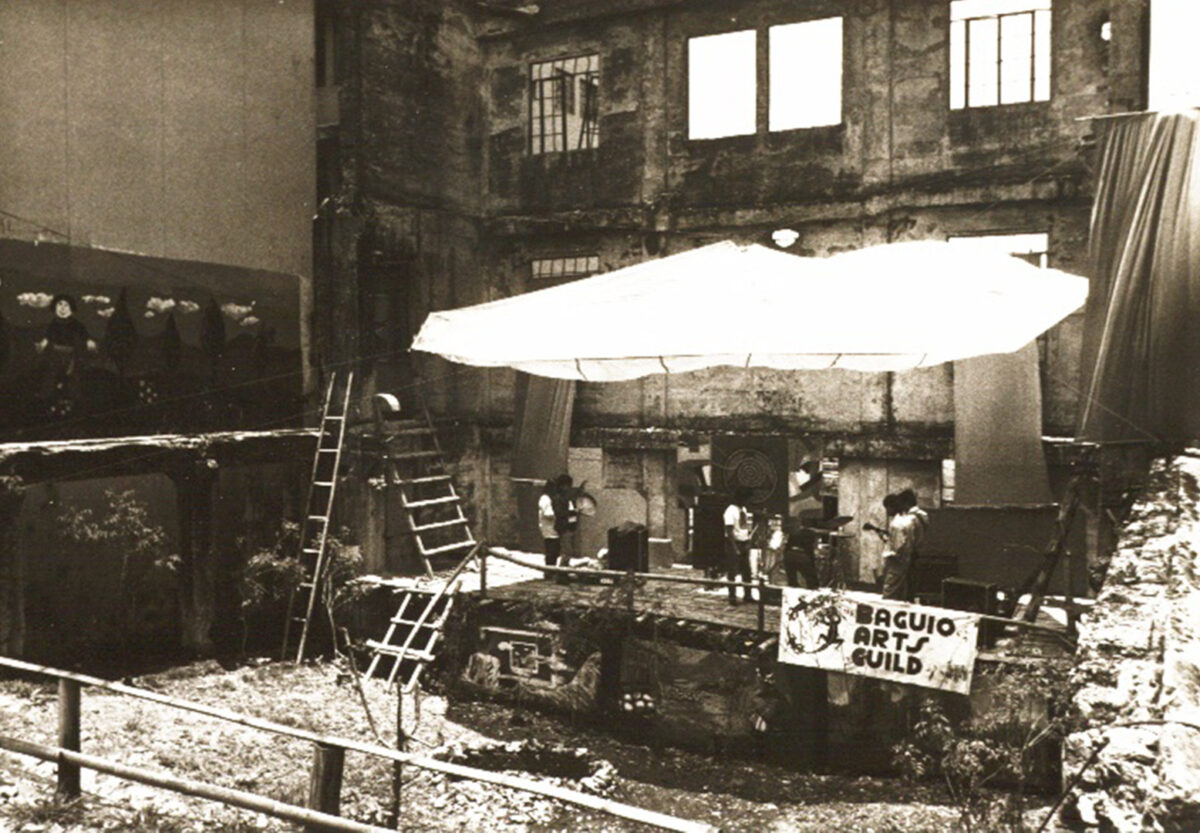
In 1992, the Indigenous inclination of BAG was inscribed into a narrative of modernism when three of its members—Villanueva, Tommy Hafalla, and Willy Magtibay—received the Thirteen Artists Awards from the CCP. The Thirteen Artists was first conceived as an exhibitionary project in 1970. Then CCP director Roberto Chabet pinned its lineage to the historical group of Filipino modernists who had turned away from Classical values. The loose metric upon which he based the selection of artists—“recentness, a turning-away from past, familiar modes of art-making”3Roberto Chabet, Thirteen Artists, exh. brochure (Cultural Center of the Philippines, 1970), unpaginated.—expressed the modernist urge for forward traction which oriented succeeding iterations of the awards. The attention given to BAG in 1992, however, suggests other institutional desires. In his notes as CCP director for visual arts, Virgilio Aviado praised the awardees’ use of “old, ancient and traditional methods for modern expression.”4Virgilio Aviado, 13 Artists Awards 1992, exh. cat. (Cultural Center of the Philippines, 1992), unpaginated. Pointing to pursuits such as “the retribalization of the Filipino” and the search for identity through a recuperation of traditions, this sentiment stresses the national as it draws on the otherness of Indigeneity as a modernist cipher of the authentic.5Aviado, 13 Artists Awards 1992, unpaginated.
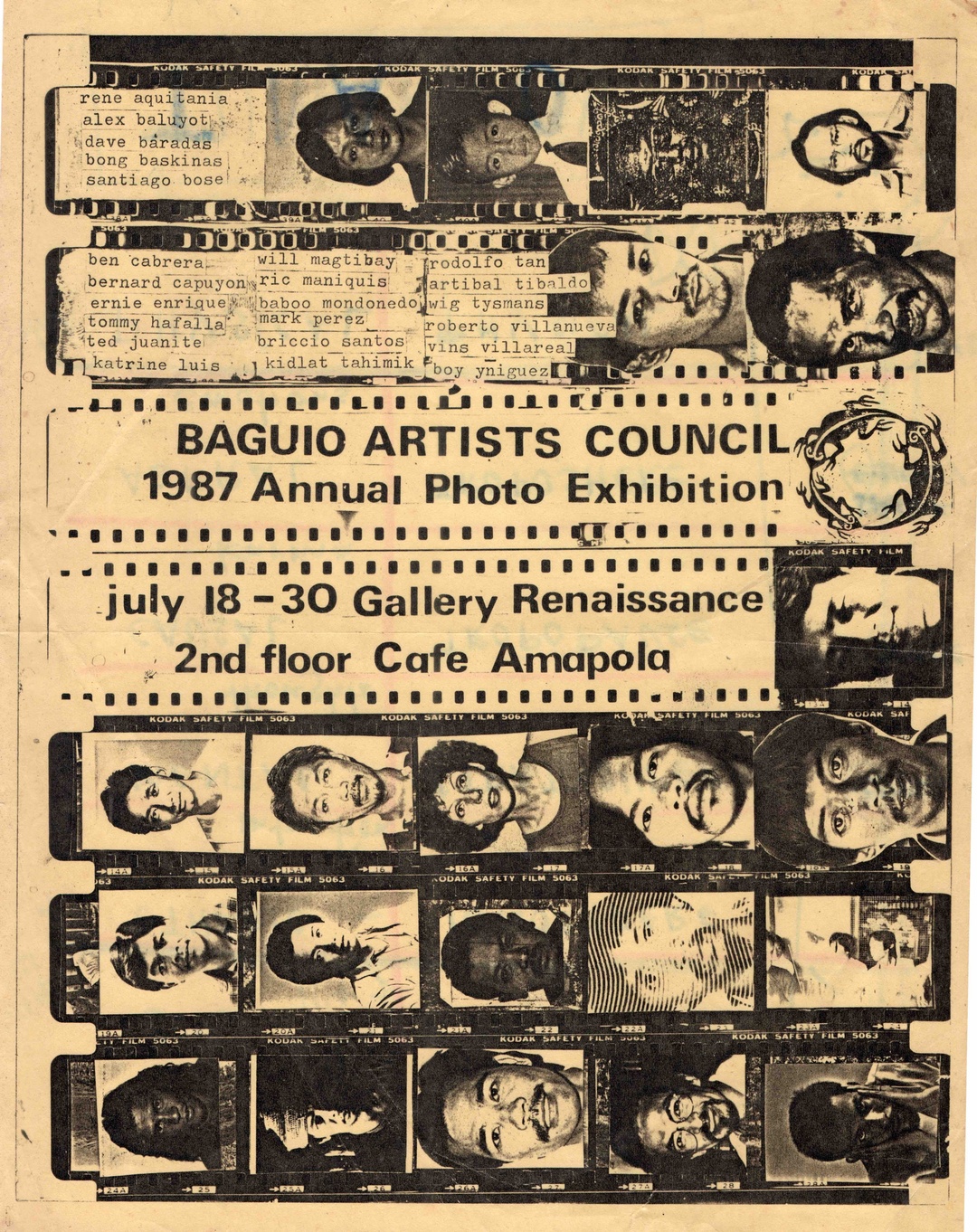
The term “tradition” is in itself duplicitous, one that assumes diverse uses in countries that share colonial histories. Art historians Geeta Kapur and Leonor Veiga, in tracing fragments of tradition within the largely secularized arenas of Indian and Indonesian art, rethink the notion of tradition as an ancestral practice that has survived modernization. Kapur approaches it as “an ambivalent, often culpable sign,” deployed in post-colonial nation-building, at times conceived and re-functioned for nationalist aims.6Geeta Kapur, “Contemporary Cultural Practice: Some Polemical Categories,” Social Scientist 18, no. 3 (1990): 51, https://doi.org/10.2307/3517425. Veiga cites British historian Eric Hobsbawm’s argument that the invention of tradition, often prompted by the birth of the modern nation-state, attempts to repair the “social voids caused by secularization.”7Leonor Veiga de Oliveira Matos Guilherme, The Third Avant-Garde: Contemporary Art from Southeast Asia Recalling Tradition (PhD thesis, Centre for the Arts in Society, Humanities, Leiden University, 2018), 50, https://scholarlypublications.universiteitleiden.nl/handle/1887/62200. Whether enacted on the level of the state or at the grassroots, the process of invention can be essentialist in its appropriations, as it lifts an ideal tradition from a ritual milieu and casts it along the quest for nationhood, identity, and origins.
It is from these discursive frames that I draw the term “invention”—but in conceiving it as a guise, I refer to invention as an activity that is intimate in that it arises out of appearance and bodily enactments. Its pronounced exteriority, commanding recognition through all its elaborate adorning, nonetheless strives for a depth of affinity. Shamanism is traditionally practiced within paradigms of the magical and the religious. The shaman is a medium who brings access to the sacred in communal life. Villanueva echoes this function of mediality and retools it into a poetics. In an undated essay titled “Cosmology in Art: An Experiential Process,” he writes that it “is the unique position of the artist as a go-between of the visual and recognizable world and that of the world that is beyond phenomena that strengthens the artist’s role in the society.”8Roberto Villanueva, “Cosmology in Art: An Experiential Process,” unpublished typescript, undated, Roberto Villanueva Folder, Pinaglabanan Galleries Archive, Quezon City (hereafter RVF). By rendering sensuous form to “unconscious feelings and thoughts of the social environment,”9Villanueva, “Cosmology in Art.” the artist-medium, much like the shaman, is seen to perform both a psychic duty and a social one. The artist may not necessarily aspire to summon the sacred but at least to access the subliminal through communal experience.
Early on, Villanueva’s poetics of a world-beyond-phenomena materialized in what several writers had contemporaneously tagged as his surrealist paintings. Taking part in a 1975 exhibition that announced the surrealistic as a common ground, Villanueva relished the ways in which this pictorial modality granted him “a freedom of expression” to mine “dreams, desires, and even fears,” a subliminal repertoire from which he found “a greater sense of realism.”10Roberto Villanueva, quoted in “Robert Villanueva,” Women’s Journal, November 15, 1975, 16. Painting butterflies and arid terrains with winged and “evolutionary beasts,”11Villanueva, quoted in “Robert Villanueva,” 16. the artist signaled the dreamlike before assuming the register of social allegory, like the painting Aqui descansa el rio defunto, Pasig; año 1985, which divines the degradation of the Pasig River.
In these secular visions, the painter, allied to the prophet or seer, foils a faithful inscription of an external reality; he prefers the clairvoyant register to signal a harboring malaise. The subliminal in Archetypes may refer to the visceral qualities of ritual revelry heightened by drumming and dancing as well as to understandings of the primordial—from Indigeneity to the archetype of a labyrinth. Villanueva notes the archetype’s recurrence “in many ancient cultures—from Ancient Egypt to Neolithic Europe, particularly England, to the American Indians, the Chinese, the Australian Aborigines.”12Roberto Villanueva, “Archetypes,” unpublished essay, undated, RVF. Through the motifs and sociality of ritual, artist and viewer are presumably drawn closer to a primordial consciousness rooted in Indigeneity—an affinity that is nonetheless anomalous as it assumes that psychic license can collapse material difference.
Villanueva was raised in Metro Manila, the urban center of modernization in an archipelago defined by ethnic, linguistic, and cultural diversity. Indigeneity and tradition typically correspond to an imagination of what lies beyond this center, a vision of cultural periphery conceived according to colonial delineations of territory. Ethnolinguistic groups in the Cordilleran highlands, having resisted Spanish colonial efforts, retained significations of otherness during the American occupation as they cast a reverse-image of what was largely seen as a Hispanized and Christianized population in the lowlands. In Philippine modernist painting, this otherness becomes material for an artist’s self-conscious evocations of identity and shared origins, which are at times prone to essentialist portrayals. As Filipino art historian Flaudette May Datuin remarks of modernist Victorio Edades’s depictions of a Cordilleran idyll in Two Igorot Women (1913), “Identity is presented as an eternal and unchanging ‘primitive’ or ‘ethnic’ moment, often associated with the chthonic and submissive female ‘savage.’”13Flaudette May V. Datuin, “Imaging/Restaging Modernity: Philippine Modernism in An/Other Light,” in Perspectives on the Vargas Museum Collection: An Art Historical and Museological Approach, ed. Patrick D. Flores (Quezon City: Jorge B. Vargas Museum and Filipiniana Research Center, 1998), 53.
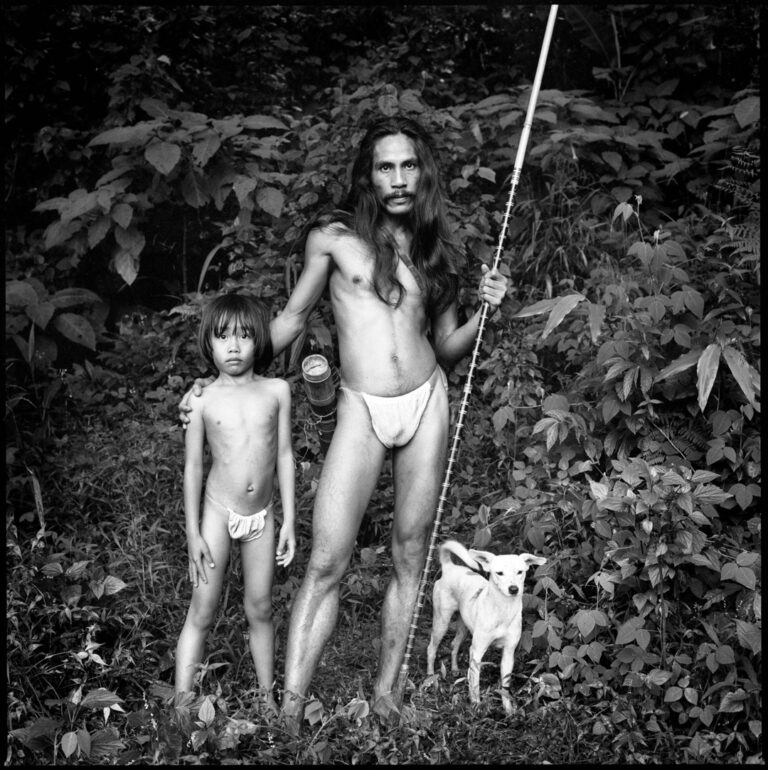
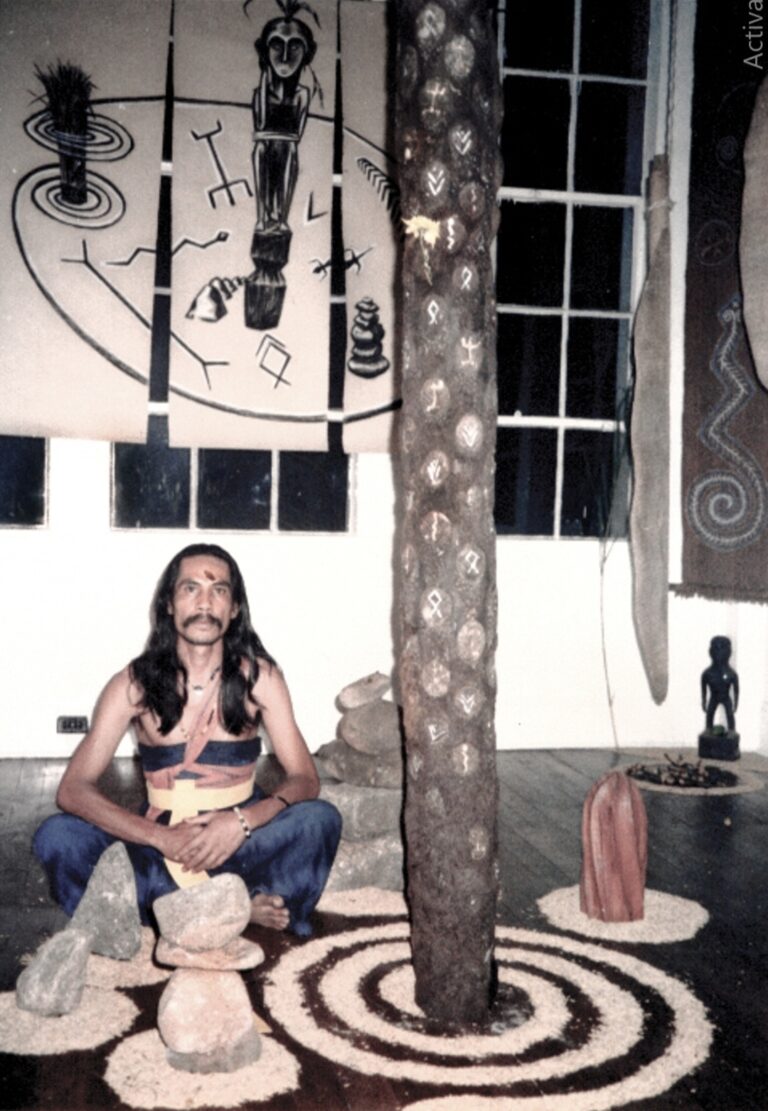
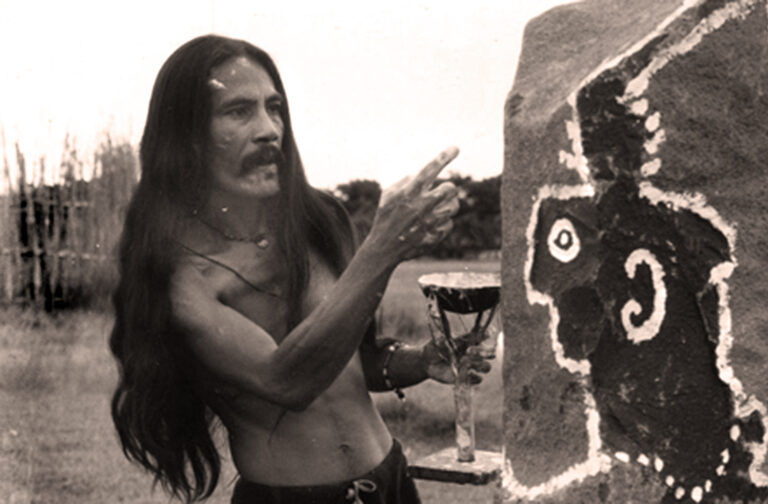
Villanueva’s anomaly rests on a more pronounced representational ambivalence as it is the artist’s body that gestures and personifies, while the otherness of the highlands remains the milieu’s chief source of invention.14The revivalist attitude is echoed, for instance, by BAG member and anthropologist David Baradas in the essay “Philippine Indigenous Aesthetics” as he praises what he refers to as the “Other Philippines,” the place of ethnic minorities, as “a world of pristine patterns, of communion with nature, and of unvanquished spirit,” to which “the larger culture turns . . . when it wishes to convey a sense of unique traditions.” See David B. Baradas, “Philippine Indigenous Aesthetics,” Philippine Studies 42, no. 3 (Third Quarter 1994): 367. The fraught territorial divides—wherein periphery and center ideologically align with constructions of tradition and modernity—produce anxieties surrounding the right to represent. Villanueva’s shamanism may thus inspire contrasting attitudes: on the one hand, the celebratory yearning for precolonial identity and then, on the other, the charge of appropriation and self-exoticization. If both these viewpoints spin on tense questions of authenticity, might other readings be possible when we consider what it is about the mediality of the artist-shaman that is fruitfully anomalous?
Villanueva’s biography unwittingly subverts the myth of identity as origin. The anomaly of a body standing in as a medium, proxy, or artifice emphasizes identity’s performativity, one that entails a prolonged process of affinity to stage and to overcome its masquerade. His consciousness of ethnic diversity developed during his childhood visits to Palawan and, eventually, through projects in documentary filmmaking, where he observed and befriended Indigenous groups in several parts of the country. In the late 1970s, dismayed by what anthropologist and BAG member David Baradas has described as a commercialized arts scene that favored homogenizing Western styles, Villanueva moved from Manila to Baguio.15David Baradas, “Roberto’s Art,” The Gold Ore: The People’s Newspaper [Baguio City], December 26, 1987. This transition brought crushing financial strains; he was then a young father developing an art practice with little commercial or institutional support. What perhaps relieved these precarities was a growing sense of affinity with the thriving cultural and spiritual life he encountered in his visits to the Cordilleras—an affective kinship that differs from systematic ethnography. Scholar Katrin de Guia notes Villanueva’s apprenticeship with an Ifugao mumbaki as well as his visits to healers and mystics in Japan, the United States, and Australia.16Katrin de Guia, “The Filipino Culture-Bearer Artist as Shaman,” in Kapwa: The Self in the Other; Worldviews and Lifestyles of Filipino Culture-Bearers (Pasig: Anvil Publishing, 2005): 78.
This affinity with the Indigenous coalesced into a politics of identity through the formation of BAG in 1987. The end of the decade witnessed demands for the state to establish regional autonomy in the Cordilleras. Members of BAG foregrounded cultural identity by inflecting genres of Western origins—film, painting, photography, sculpture, performance—with markers of the local. Materials were sourced from immediate environments and themes carried Indigenous motifs. As an alternative to the secular, commercial, and individualized model of art production in Manila, BAG advanced an ethos of communality: disciplined, spirited organizing—which bred the artist-run international Baguio Art Festival—and a freewheeling camaraderie among travelers, musicians, performers, and artists of all persuasions. The modernist atmosphere of experimentation energized BAG’s postcolonial quest—a quest not just for national origins but also for a real sense of originality, a defining self-consciousness that yielded, for Villanueva, the liberties and the conceit of representation.
In probing the meeting points between tradition and modernity, Geeta Kapur advises us to look “not for hybrid solutions . . . but for a dialectic.”17Geeta Kapur, “Dismantled Norms: Apropos Other Avantgardes,” in Art and Social Change: Contemporary Art in Asia and the Pacific, ed. Caroline Turner (Canberra: Pandanus Books, 2005): 67. Leonor Veiga then nominates the category of a “third avant-garde” that recognizes the postcolonial agency of artists in using appropriation as a conceptual strategy to capture tradition’s transgressive stance. The “third avant-garde,” in undoing “the taxonomical division between art and ethnography,”18Veiga de Oliveira Matos Guilherme, The Third Avant-Garde, 61. fulfills what Kapur has described as a “double-dismantle.”19Geeta Kapur referenced in Veiga de Oliveira Matos Guilherme, The Third Avant-Garde, 7. It objects to invented traditions that serve nationalist interests, and it defies the Western monopoly of the avant-garde.20Veiga de Oliveira Matos Guilherme, The Third Avant-Garde, 121. While much of Veiga’s astute propositions resonate with the conditions of BAG—chiefly, with its ambitions to undo Western aesthetic models and modes of display—Villanueva’s visceral and spiritual performances seem somewhat at odds with the transgressive, radical, and antagonistic edge that defines the vanguardist posture.
The artist-shaman is positioned here as an anomalous figure of postcolonial modernity. What I have been describing as an anomaly is motivated less by the wish to advance than by a long look backward, a nostalgic turning that is naively but also deliberately revivalist in its urges. In working with ritual, however, Villanueva was not only concerned with the symbolic operations that bind it to tradition but also interested in its facture, its design, and its plasticity, recalling the modernist fascination with medium specificity and surface. The artist-shaman thus commits impieties in their revivals, animating the atmosphere of ritual while remaining unfaithful to its ethnographic source.
An anomaly is an instance of irregularity, an improbability, or a moment of anachronism; it derives its effects by virtue of its dislocations. When Villanueva traveled to stage more ritualistic performances in countries like Japan and New York, he seemed more inclined to approach Indigeneity as an activity of invention and guise. It is perhaps the artist-shaman’s more improvised works, like the 1991 project Panhumuko, that reveal another side to his mediality. Largely intuitive, diverging from the elaborate ensembles of Archetypes, Panhumuko foregrounds the shared, symbolic, subliminal space of ritual, which is also a conceptual space to address modernity and its attendant malignancies.
Showman/Shaman documents the performance.21Showman/Shaman, directed and produced by Egay Navarro and Rica Concepcion, 2003. In 1991, the eruption of Mount Pinatubo in central Luzon displaced several Indigenous Aeta communities, forcing them into evacuation camps. Panhumuko, a Sambal word that translates as “surrender,” was prompted by the intention to make an offering that could appease Apo Namalyari, a deity of the Aetas. Around this time, Villanueva had been preparing to travel to New York to serve as an artist-in-residence upon the invitation of the Filipino cultural group Amauan.22The residency was supported by a grant given by the New York State Council on the Arts. He was conceiving an engagement that could inform his work at the residency. Villanueva, accompanied by documentarians and a linguist, made the trip to Zambales to find Aetas receptive to holding a ritual offering. The plan did not work with one group, but he was welcomed by another, whose elders (whom he described as “shamans of the community”) reacted with enthusiasm.23Villanueva, “Cosmology in Art.”
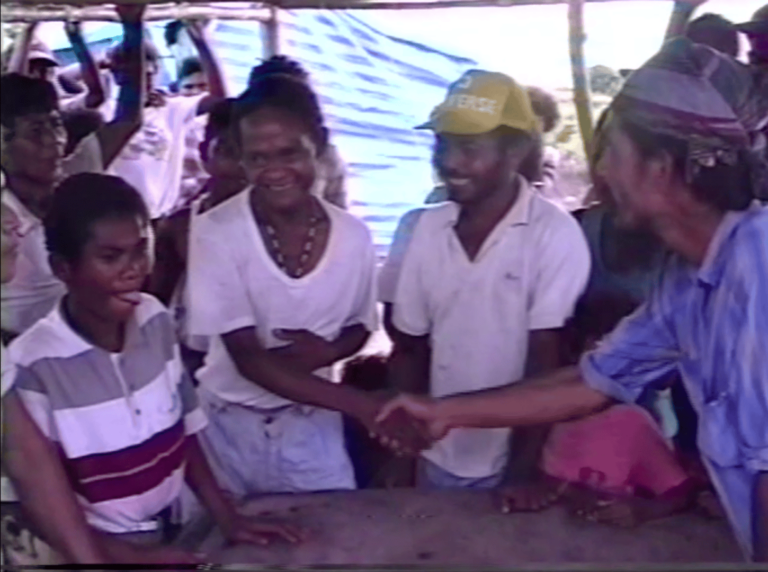
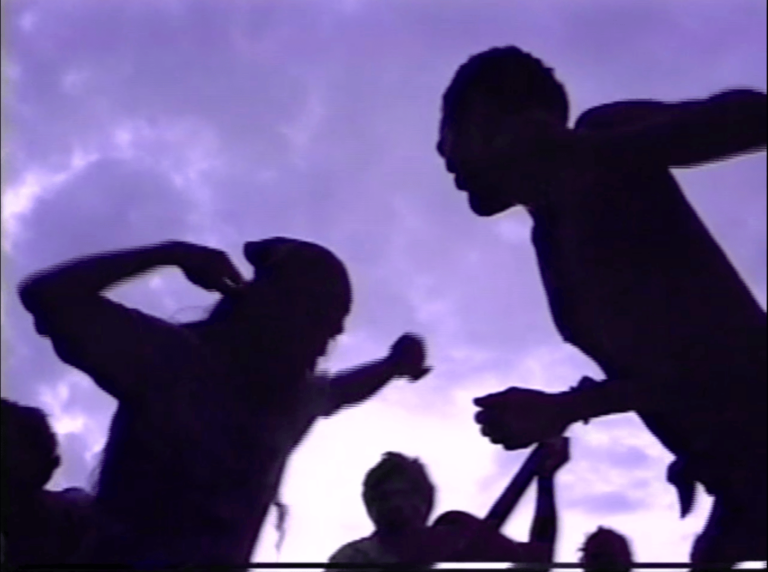
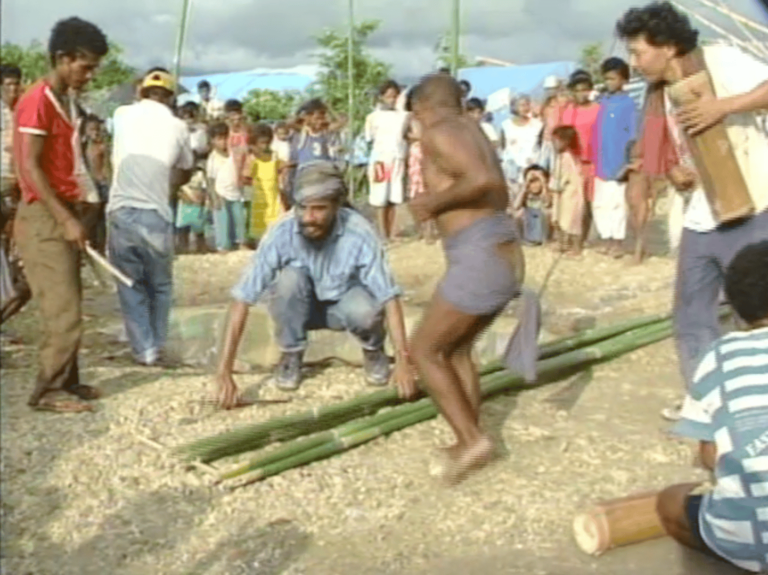
The central element of this project was the ritual atmosphere approximating a collective trance; the making of the installation-offering appeared like a means to achieve this end. Improvisation, play, and eclecticism marked Panhumuko: Cordilleran dances inspired Villanueva’s actions, the Aetas made percussive sounds with bamboo drums and tin cans, and intuitively, the group assembled the installation by an open well by scattering coals, erecting bamboo stems, hanging vegetables, and arranging candles shaped in human form. A semblance of this resulting material form was then constructed as an indoor installation at Lincoln Square Gallery, New York a month after. Villanueva’s impious, eclectic acts seem like an echo of folk religiosity, a cultural response to the colonial imposition of Christian belief. Writing about the human-shaped candles taken from Quiapo Church in Manila, Villanueva relays his fascination with these ritual objects whose “roots are in the animistic traditions of the past” but are now integrated in Christian practices, an integration he regards as “one of the richest points in Filipino culture.”24Villanueva, “Cosmology in Art.”
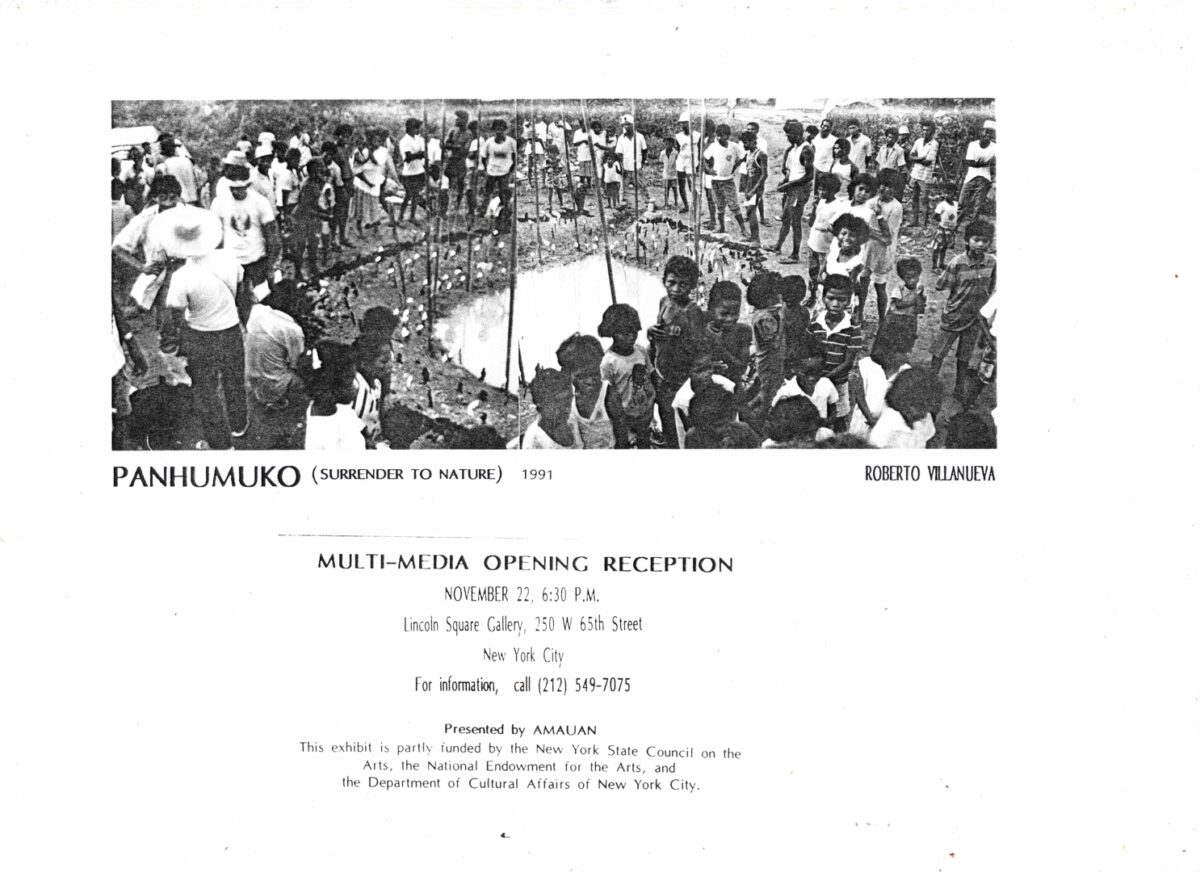
Villanueva’s ritual performances may be read as sites of a similar dialectic. Episodes of calamity most sharply manifest an existential rupture, what Villanueva intuits as “man’s alienation from nature,” which brings about environmental havoc.25De Guia, “The Filipino Culture-Bearer Artist as a Shaman,” 61. The poetics of a world-beyond-phenomena—fulfilled in Panhumuko as a communal experience of psychic release—signal a postcolonial disavowal of modernization’s rational processes. Villanueva favors installations because their assembly calls for communal acts that “quiet the rattles of intellect and allows intuition to reign.”26Villanueva, “Cosmology in Art.” For hours in Zambales, drumming, dancing, and chanting ensue as they build the offering. As a performative gesture, Panhumuko attempts to alleviate a collective unease toward modernity’s malignancies, here construed as calamity, loss of community, and ecological disconnect.27The ecocritical dimension in Roberto Villanueva’s body of work is most thoroughly explored in Midori Yamamura, “Making the Art Object Disappear: Roberto Villanueva’s Response to the Anthropocene,” in Eco-Art History in East and Southeast Asia, ed. De-nin Deanna Lee (Newcastle upon Tyne: Cambridge Scholars Publishing, 2019): 87–136.
Villanueva held Indigeneity as a modality of being that may yield a cure for modern problems. The artist then assumed the role of a medium to access an eroded subjectivity or to approximate its guise. What he aspired for, it seems, was an exit from modernity, an exit that was never totally fulfilled when modernity created the conditions for his agency and emergence. The anomaly of ritual proceeds from the artist-shaman’s autonomy and invention. Villanueva’s charismatic performances, while sympathetic to Indigeneity, claim a duplicitous worldliness, an independence that appears to keep him unbeholden to one group or spiritual belief. It is through this anomalous position that he performed his dislocations, ruptured categories, and constituted the self as an improbability.
The artist died of leukemia in 1995. The early onset of illness and exhaustion may have manifested in the pain he expressed during the ritual of Panhumuko, which led the Aeta elders to initiate a curing ritual.28Midori Yamamura, a contemporary of Villanueva, speculates that the artist felt the early onset of leukemia during the performance. See Midori Yamamura, “Making the Art Object Disappear,” 125. If an anomaly absorbs the time’s contradictions, the modern played out its paradox fully through his body, through to its demise, as though the shaman also absorbed the very malignancy he sought to cure. This emblematic affliction finally makes palpable the contradictory status assumed by the artist and the shaman in modernity, as these figures dwell at the tense point of magicality and marginalization that comes with embodied, material, and terminal pains. To foreground an anomaly is to anticipate such fetishizations, duplicities, and ambivalences. Villanueva’s shamanism was in some ways a show and a representative conceit. It was also a profound affinity, an invention that was, at the same time, his becoming.
The author is grateful to Agnes Arellano, Billy Bonnevie, Rica Concepcion, and Kawayan de Guia for sharing their archives, documentation, and memories.
- 1The installation is also referred to as Uman di Biag (Garden of Life).
- 2Charlson L. Ong, “Tales of the Mumbaki,” Daily Globe [Manila], May 22, 1989.
- 3Roberto Chabet, Thirteen Artists, exh. brochure (Cultural Center of the Philippines, 1970), unpaginated.
- 4Virgilio Aviado, 13 Artists Awards 1992, exh. cat. (Cultural Center of the Philippines, 1992), unpaginated.
- 5Aviado, 13 Artists Awards 1992, unpaginated.
- 6Geeta Kapur, “Contemporary Cultural Practice: Some Polemical Categories,” Social Scientist 18, no. 3 (1990): 51, https://doi.org/10.2307/3517425.
- 7Leonor Veiga de Oliveira Matos Guilherme, The Third Avant-Garde: Contemporary Art from Southeast Asia Recalling Tradition (PhD thesis, Centre for the Arts in Society, Humanities, Leiden University, 2018), 50, https://scholarlypublications.universiteitleiden.nl/handle/1887/62200.
- 8Roberto Villanueva, “Cosmology in Art: An Experiential Process,” unpublished typescript, undated, Roberto Villanueva Folder, Pinaglabanan Galleries Archive, Quezon City (hereafter RVF).
- 9Villanueva, “Cosmology in Art.”
- 10Roberto Villanueva, quoted in “Robert Villanueva,” Women’s Journal, November 15, 1975, 16.
- 11Villanueva, quoted in “Robert Villanueva,” 16.
- 12Roberto Villanueva, “Archetypes,” unpublished essay, undated, RVF.
- 13Flaudette May V. Datuin, “Imaging/Restaging Modernity: Philippine Modernism in An/Other Light,” in Perspectives on the Vargas Museum Collection: An Art Historical and Museological Approach, ed. Patrick D. Flores (Quezon City: Jorge B. Vargas Museum and Filipiniana Research Center, 1998), 53.
- 14The revivalist attitude is echoed, for instance, by BAG member and anthropologist David Baradas in the essay “Philippine Indigenous Aesthetics” as he praises what he refers to as the “Other Philippines,” the place of ethnic minorities, as “a world of pristine patterns, of communion with nature, and of unvanquished spirit,” to which “the larger culture turns . . . when it wishes to convey a sense of unique traditions.” See David B. Baradas, “Philippine Indigenous Aesthetics,” Philippine Studies 42, no. 3 (Third Quarter 1994): 367.
- 15David Baradas, “Roberto’s Art,” The Gold Ore: The People’s Newspaper [Baguio City], December 26, 1987.
- 16Katrin de Guia, “The Filipino Culture-Bearer Artist as Shaman,” in Kapwa: The Self in the Other; Worldviews and Lifestyles of Filipino Culture-Bearers (Pasig: Anvil Publishing, 2005): 78.
- 17Geeta Kapur, “Dismantled Norms: Apropos Other Avantgardes,” in Art and Social Change: Contemporary Art in Asia and the Pacific, ed. Caroline Turner (Canberra: Pandanus Books, 2005): 67.
- 18Veiga de Oliveira Matos Guilherme, The Third Avant-Garde, 61.
- 19Geeta Kapur referenced in Veiga de Oliveira Matos Guilherme, The Third Avant-Garde, 7.
- 20Veiga de Oliveira Matos Guilherme, The Third Avant-Garde, 121.
- 21Showman/Shaman, directed and produced by Egay Navarro and Rica Concepcion, 2003.
- 22The residency was supported by a grant given by the New York State Council on the Arts.
- 23Villanueva, “Cosmology in Art.”
- 24Villanueva, “Cosmology in Art.”
- 25De Guia, “The Filipino Culture-Bearer Artist as a Shaman,” 61.
- 26Villanueva, “Cosmology in Art.”
- 27The ecocritical dimension in Roberto Villanueva’s body of work is most thoroughly explored in Midori Yamamura, “Making the Art Object Disappear: Roberto Villanueva’s Response to the Anthropocene,” in Eco-Art History in East and Southeast Asia, ed. De-nin Deanna Lee (Newcastle upon Tyne: Cambridge Scholars Publishing, 2019): 87–136.
- 28Midori Yamamura, a contemporary of Villanueva, speculates that the artist felt the early onset of leukemia during the performance. See Midori Yamamura, “Making the Art Object Disappear,” 125.
